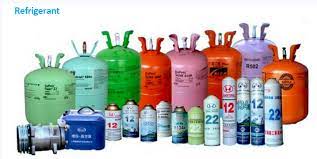What Is Refrigerant?
A Refrigerant Gas Pakistan is composed of chemical and gas substances. It serves to absorb heat emitted by refrigerators and release it back out as chilled storage in your fridge. A refrigerant serves its purpose by switching back and forth between condenser and evaporator regularly, cooling all refrigeration/air conditioning systems that rely on its services.
Decades ago, Hydrochlorofluorocarbons (HCFCs), Hydrofluorocarbons (HFCs), and Chlorofluorocarbons (CFCs) were frequently employed, yet due to their ozone depleting properties they quickly fell out of favor. Today however, environmentally-friendly Refrigerant Gas Pakistan such as Hydrocarbons and hydrofluoroolefins are being utilized instead.
Refrigerant Workings
Refrigeration involves pumping refrigerant through an evaporator that converts it to vapors to absorb heat from your refrigerator, before being passed through a compressor to be cooled down by its heat absorption and release through its condenser for release of heat through condenser back into liquid state – before eventually cooling the interior of your fridge with additional refrigerant running through its cycle before continuing its journey back through condenser again. Refrigeration utilizes refrigerant to effectively lower its temperature, and thus ensure perishable food items can remain cool during their shelf life.
Environment Regulations (ERs)
Before 1800 and 1920, only toxic Refrigerant Gas Pakistan were utilized in refrigeration units such as refrigerators or air conditioning units, leading to loss of ozone layer protection as well as an imbalanced greenhouse effect. Scientists started to recognize the adverse side-effects of using an amalgamation of fluorine, chlorine and carbon as refrigeration refrigerants around 1920. Following this discovery, international regulations and agreements were put in place which prohibited their use due to environmental concerns. Montreal Protocol and European F-gas Regulation have both contributed significantly to maintaining our environment’s health by banning harmful gases and encouraging more eco-friendly alternatives. These steps have made an undeniable impact in maintaining it for future generations.
Types of Refrigerants
Refrigerators use various types of refrigerants; some were discontinued due to their environmental hazards while others are encouraged due to their low global warming potential (GWP). A sampling of such gases includes:
Dichlorodifluoromethane
R-12 or Dichlorodifluoromethane was once commonly used as a refrigerator coolant until its harmful impact on the ozone layer led to it being discontinued and later banned from further usage.
Chlorodifluoromethane
R-22 Refrigerant, otherwise known as Chlorodifluoromethane, was once widely used in refrigerators but has since been banned due to its harmful ozone depleting properties and is no longer commonly employed as an effective refrigerant.
1,1,1,2-Tetrafluoroethane
R134a refrigerant gas also known by its chemical name of 1,1,1,2-Tetrafluoroethane is widely used as an HFC modern refrigerant, widely utilized in refrigeration operations today due to its superior cooling abilities, eco-friendliness, low depletion rate of ozone depletion, low depletion rate rate and very significant Global Warming Potential (GWP). However, R-134a’s Global Warming Potential is even greater.
Isobutane
R-600a (Isobutane): This hydrocarbon has an extremely low global Warming Potential and no Ozone Depletion Rate. This hydrocarbon offers excellent cooling properties with no environmental impact whatsoever and no Halogens present, making it a favorite choice among home refrigerants, while remaining highly flameproof.
Propane
R-290a is more commonly referred to as Propane. Propane is an extremely green hydrocarbon refrigerant gas with no depletion rate of ozone that has made it a top choice in refrigeration systems due to its outstanding specifications, such as high quality cooling properties and zero depletion rate of ozone depletion rate – making it the go-to refrigerant gas! Furthermore, with such a low global warming potential index (GWP).
carbon dioxide
R-744: Commonly referred to as carbon dioxide, R-744 is an eco-friendly natural gas commonly utilized by high-end homes due to its green credentials. With an environmental Global Warming Potential index rating of 1, it makes R-744 an eco-friendly gas option that should not be overlooked when selecting their source energy supplier.
Freon
R-438a, commonly referred to as Freon, can be used as an environmentally-friendly replacement for R-22. Unlike its counterpart, however, R-438a does not contribute to depleting ozone levels in the environment.
Refrigerators are among the many appliances that rely on refrigerant or gas to function, which helps cool food items while simultaneously eliminating germs from them. But not all gasses are equally good for the environment – once aware of this fact, make an informed decision when purchasing or filling up a fridge with gas; doing so may reduce Global Warming effects while helping decrease your carbon footprint and help save our planet!

